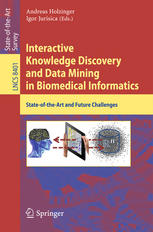

Most ebook files are in PDF format, so you can easily read them using various software such as Foxit Reader or directly on the Google Chrome browser.
Some ebook files are released by publishers in other formats such as .awz, .mobi, .epub, .fb2, etc. You may need to install specific software to read these formats on mobile/PC, such as Calibre.
Please read the tutorial at this link: https://ebookbell.com/faq
We offer FREE conversion to the popular formats you request; however, this may take some time. Therefore, right after payment, please email us, and we will try to provide the service as quickly as possible.
For some exceptional file formats or broken links (if any), please refrain from opening any disputes. Instead, email us first, and we will try to assist within a maximum of 6 hours.
EbookBell Team

4.4
72 reviewsOne of the grand challenges in our digital world are the large, complex and often weakly structured data sets, and massive amounts of unstructured information. This “big data” challenge is most evident in biomedical informatics: the trend towards precision medicine has resulted in an explosion in the amount of generated biomedical data sets. Despite the fact that human experts are very good at pattern recognition in dimensions of <= 3; most of the data is high-dimensional, which makes manual analysis often impossible and neither the medical doctor nor the biomedical researcher can memorize all these facts. A synergistic combination of methodologies and approaches of two fields offer ideal conditions towards unraveling these problems: Human–Computer Interaction (HCI) and Knowledge Discovery/Data Mining (KDD), with the goal of supporting human capabilities with machine learning.
This state-of-the-art survey is an output of the HCI-KDD expert network and features 19 carefully selected and reviewed papers related to seven hot and promising research areas: Area 1: Data Integration, Data Pre-processing and Data Mapping; Area 2: Data Mining Algorithms; Area 3: Graph-based Data Mining; Area 4: Entropy-Based Data Mining; Area 5: Topological Data Mining; Area 6 Data Visualization and Area 7: Privacy, Data Protection, Safety and Security.